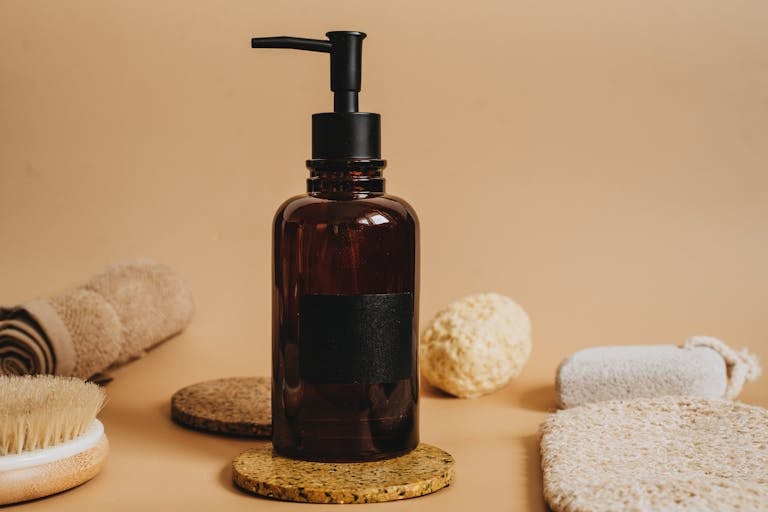
In the ever-evolving world of skincare, sometimes the most effective solutions are rooted in ancient wisdom. Enter the oil cleansing method, a practice that might initially seem counterintuitive but is rapidly gaining traction among skincare enthusiasts and natural beauty advocates alike. If you’ve ever found yourself frustrated with conventional cleansers that leave your skin feeling tight, dry, or irritated, it might be time to consider an approach that works with your skin’s natural processes rather than against them.
The concept of washing your face with oil might raise eyebrows at first. After all, many of us have spent years trying to combat excess oil on our skin, not adding to it. However, this method challenges our long-held beliefs about skincare and offers a gentler, more holistic approach to cleansing. By harnessing the power of natural oils, the oil cleansing method promises not just to clean your skin, but to nourish, balance, and revitalise it.
As we delve deeper into this topic, we’ll explore the science behind oil cleansing, its numerous benefits, and how it can be tailored to suit different skin types. Whether you’re dealing with persistent acne, battling dryness, or simply looking for a more natural approach to your skincare routine, the oil cleansing method offers an intriguing alternative worth considering.
So, let’s embark on this journey into the world of oil cleansing. You might just discover that the key to clear, balanced skin has been hiding in your kitchen cupboard all along.
What is the Oil Cleansing Method?
The oil cleansing method is a skincare technique that replaces traditional soap-based cleansers with natural oils. At its core, this method is based on a simple scientific principle: like dissolves like. In practical terms, this means that the oils you apply to your skin can effectively dissolve and remove the excess sebum, dirt, and makeup that accumulate throughout the day.
Unlike conventional cleansers that often strip the skin of its natural oils, potentially leading to dryness or increased oil production, the oil cleansing method aims to work in harmony with your skin’s natural processes. It’s not just about removing impurities; it’s about nourishing and balancing the skin at the same time.
The History of Oil Cleansing
While it might seem like a modern trend, the use of oils for cleansing has roots in ancient beauty practices. Many cultures, including those in ancient Egypt, Greece, and Rome, used oils as part of their cleansing and beautification rituals. In recent years, this age-old practice has been rediscovered and adapted for modern skincare routines.
The Science Behind Oil Cleansing
The effectiveness of oil cleansing lies in the chemical properties of oils. Oils are non-polar molecules, meaning they can bind with other non-polar molecules like sebum and makeup residue. When you massage oil into your skin, it binds with these impurities, allowing them to be easily wiped away.
Many of the oils used in this method contain beneficial compounds such as vitamins, antioxidants, and fatty acids. These can help nourish the skin, support its natural barrier function, and even provide mild antimicrobial properties.
Types of Oils Used
The oil cleansing method typically involves a blend of oils, often including:
- Castor Oil: Known for its cleansing and purifying properties.
- Jojoba Oil: Similar in composition to human sebum, making it suitable for most skin types.
- Olive Oil: Rich in antioxidants and vitamins.
- Grapeseed Oil: Light and easily absorbed, good for oily skin.
- Avocado Oil: Deeply moisturising, beneficial for dry skin.
The choice and ratio of oils can be customised based on individual skin types and concerns.

Debunking Myths
One common misconception about the oil cleansing method is that it will make oily skin worse. In reality, many people find that their skin’s oil production balances out over time. By providing adequate moisture and not stripping the skin, oil cleansing can actually help regulate sebum production.
The oil cleansing method represents a shift in how we approach skincare. Instead of fighting against our skin’s natural processes, it encourages us to work with them, potentially leading to healthier, more balanced skin.
Benefits of Oil Cleansing
- Gentle, Effective Cleansing: The oil cleansing method offers a remarkably gentle yet thorough cleansing experience. Unlike harsh, soap-based cleansers that can strip your skin of its natural oils, this method effectively removes dirt, excess sebum, and makeup without disrupting your skin’s delicate balance. The oils used bind with impurities, allowing them to be easily wiped away, leaving your skin clean and refreshed without that tight, dry feeling often associated with traditional cleansers.
- Balances Oil Production: Counterintuitive as it may seem, using oil to cleanse can actually help balance your skin’s oil production. When you constantly strip your skin of its natural oils with harsh cleansers, it may overcompensate by producing even more oil. The oil cleansing method helps maintain your skin’s natural oil balance. Over time, many people find that their skin becomes less oily as it no longer needs to overproduce sebum to compensate for dryness.
- Deep Moisturisation and Nourishment: Many of the oils used in this method are rich in vitamins, antioxidants, and essential fatty acids that nourish and hydrate your skin. For instance, jojoba oil is similar in composition to our skin’s natural sebum and can help regulate moisture levels. Avocado oil is packed with vitamins A, D, and E, offering deep hydration and potential anti-ageing benefits. This nourishing effect can lead to softer, more supple skin over time.
- Efficient Makeup Removal: Oils are excellent at breaking down and removing even the most stubborn makeup, including waterproof mascara and long-wearing foundations. This eliminates the need for separate makeup removers, simplifying your skincare routine. The gentle massaging action used in oil cleansing can ensure that all traces of makeup are thoroughly removed without harsh rubbing or tugging at the delicate skin around your eyes.
- Potential Improvement of Skin Conditions: Some people find that the oil cleansing method helps improve various skin conditions. For those with acne-prone skin, certain oils like tea tree or neem oil have natural antibacterial properties that may help combat breakouts. Those with dry or sensitive skin often report reduced redness and irritation. Even those with combination skin can benefit from the balanced approach of oil cleansing.
- Environmental and Cost Benefits: Adopting the oil cleansing method can be both eco-friendly and economical. By using natural oils, you reduce the need for multiple skincare products, many of which come in plastic packaging. This can lead to less waste. Additionally, a little oil goes a long way in cleansing, making this method quite cost-effective compared to purchasing multiple cleansers, toners, and makeup removers.
- Customisable to Individual Needs: One of the greatest benefits of the oil cleansing method is its versatility. You can easily customise your oil blend to suit your specific skin type and concerns. For instance, those with oily skin might opt for a higher proportion of astringent oils like castor oil, while those with dry skin might choose more nourishing oils like avocado or argan oil. This customisation allows for a truly personalised skincare experience that can be adjusted as your skin’s needs change.

How to Perform the Oil Cleansing Method
First Prepare Your Oil Blend:
Choose your oils based on your skin type. A common ratio is 1:3 castor oil to carrier oil. Here are some suggested ratios, converted to tablespoons and teaspoons:
For oily skin:
- 2 teaspoons castor oil
- 4 tablespoons + 2 teaspoons grapeseed or jojoba oil
For combination skin:
- 1 tablespoon + 1 teaspoon castor oil
- 5 tablespoons carrier oil (e.g., sunflower or jojoba oil)
For dry skin:
- 2 teaspoons castor oil
- 6 tablespoons carrier oil (e.g., avocado or almond oil)
Mix your chosen oils in a small bottle for easy dispensing. These measurements will create a larger batch that you can store and use over time.
- Set Up Your Space:
- Gather a soft, clean washcloth and have warm water ready.
- Tie back your hair to keep it out of your face.
- If wearing makeup, you may want to remove eye makeup separately to avoid excessive rubbing in this delicate area.
- Apply the Oil:
- Start with clean, dry hands.
- Pour about a 10p-sized amount of your oil blend into your palm.
- Gently rub your hands together to warm the oil.
- Apply the oil to your dry face using your fingertips.
- Massage Thoroughly:
- Using gentle, circular motions, massage the oil into your skin for 1-2 minutes.
- Pay extra attention to areas prone to congestion, like the T-zone.
- If you wear heavy makeup, you may need to use a bit more oil and massage for longer.

- Steam Your Face:
- Soak your washcloth in comfortably hot water.
- Wring out excess water and place the warm cloth over your face.
- Leave it on for about 30 seconds to 1 minute, allowing the steam to open your pores.
- Breathe deeply and enjoy this moment of relaxation.
- Wipe Away the Oil:
- Using the same washcloth, gently wipe away the oil from your face.
- Start from the centre of your face and move outwards in gentle, sweeping motions.
- Rinse the cloth in warm water and repeat until you’ve removed most of the oil.
- Optional Second Cleanse:
- For very oily skin or if wearing heavy makeup, you might want to repeat steps 3-6.
- Use a fresh, clean washcloth for the second cleanse if needed.
- Rinse and Pat Dry:
- Splash your face with lukewarm water to remove any remaining oil residue.
- Gently pat your face dry with a clean, soft towel.
- Moisturise (If Needed):
- If your skin feels tight or dry, apply a light, non-comedogenic moisturiser.
- Many people find they don’t need additional moisturiser after oil cleansing.
- Frequency and Timing:
- Start with oil cleansing once a day, preferably in the evening to remove the day’s buildup.
- In the morning, a simple water rinse is often sufficient.
- Adjust the frequency based on your skin’s response.
- Clean Up:
- Wash your washcloth thoroughly with soap and hot water after each use.
- Allow it to dry completely to prevent bacterial growth.
Remember, it may take a couple of weeks for your skin to adjust to this new method. Be patient and consistent, and adjust your oil blend as needed based on how your skin responds.
Potential Drawbacks of the Oil Cleansing Method
While the oil cleansing method can be beneficial for many, it’s important to be aware of potential drawbacks:
- Initial Breakouts: Some people may experience what’s known as a ‘purging’ phase when first starting the oil cleansing method. As the oils deep-clean your pores, they may bring existing blockages to the surface, resulting in temporary breakouts. This phase typically lasts a few weeks but can be discouraging for some users.
- Clogged Pores: If not done correctly or if using oils that are too heavy for your skin type, oil cleansing can potentially lead to clogged pores. This is particularly true for those with naturally oily or acne-prone skin. It’s crucial to choose the right oils and ensure thorough removal.
- Residue Issues: Improper removal of the oils can leave a residue on the skin, which may lead to breakouts or a greasy feeling. This is often due to not using warm enough water or not wiping thoroughly enough with a cloth.
- Time-Consuming: Compared to quickly washing your face with a standard cleanser, the oil cleansing method can be more time-consuming. The process of massaging, steaming, and thorough removal takes longer and may not be suitable for those with busy schedules.
- Inconvenience When Travelling: Carrying oils and cloths while travelling can be less convenient than packing a small bottle of facial cleanser. There’s also the risk of oil spills in your luggage.
- Stained Linens: Oil can stain towels, washcloths, and pillowcases if not completely removed from the skin. This might necessitate more frequent washing of linens or the use of dark-coloured cloths.
- Unsuitable for Some Skin Conditions: People with certain skin conditions, such as fungal acne or seborrheic dermatitis, may find that some oils exacerbate their condition. It’s always best to consult with a dermatologist before starting oil cleansing if you have a specific skin concern.
- Trial and Error Period: Finding the right combination of oils for your skin can take time and experimentation. This process can be frustrating and potentially costly if you need to try several different oils.
- Potential Allergic Reactions: As with any skincare product, there’s a risk of allergic reactions to certain oils. It’s important to patch-test any new oil before applying it to your entire face.
It’s important to remember that skincare is not one-size-fits-all. While many people swear by the oil cleansing method, others may find it doesn’t suit their skin or lifestyle. If you experience persistent irritation or breakouts after several weeks of oil cleansing, it may be best to discontinue use and consult with a dermatologist. Always listen to your skin and be willing to adjust your routine as needed.

Conclusion: Embracing the Oil Cleansing Method
The oil cleansing method represents an example of a shift in skincare, challenging conventional wisdom about how we should care for our skin. As we’ve explored throughout this article, this natural approach to face washing offers numerous benefits, from gentle yet effective cleansing to potential improvements in various skin conditions.
By harnessing the power of natural oils, the oil cleansing method works in harmony with your skin’s natural processes rather than against them. It offers a customisable solution that can be tailored to various skin types and concerns, providing a more holistic approach to skincare.
However, it’s important to remember that like any skincare routine, oil cleansing isn’t without its potential drawbacks. The initial adjustment period, the time investment required, and the possibility that it may not suit everyone’s skin are factors to consider carefully.
If you decide to try the oil cleansing method, patience and consistency are key. It may take several weeks for your skin to adjust, and you might need to experiment with different oil blends to find what works best for you. Start slowly, perhaps incorporating oil cleansing into your evening routine a few times a week, and gradually increase frequency as your skin adapts.
Remember, skincare is deeply personal. What works wonders for one person may not yield the same results for another. Listen to your skin, be willing to adjust your approach, and don’t hesitate to consult with a dermatologist if you have persistent concerns.
Ultimately, the oil cleansing method offers an intriguing alternative to traditional cleansing methods. It invites us to reconsider our relationship with our skin and the products we use on it. Whether you fully embrace oil cleansing or incorporate elements of it into your existing routine, the goal remains the same: to achieve healthy, balanced skin in a way that feels right for you.
As we continue to rediscover ancient beauty wisdom and blend it with modern understanding, methods like oil cleansing remind us that sometimes, the most effective skincare solutions are also the most natural. So why not give it a try? Your skin might just thank you for it.






